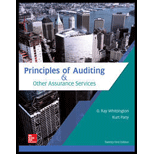
Principles Of Auditing & Other Assurance Services
21st Edition
ISBN: 9781259916984
Author: WHITTINGTON, Ray, Pany, Kurt
Publisher: Mcgraw-hill Education,
expand_more
expand_more
format_list_bulleted
Question
Chapter 15, Problem 32BOQ
To determine
Identify the appropriate answer related to the
Expert Solution & Answer
Want to see the full answer?
Check out a sample textbook solution
Students have asked these similar questions
How much was the company's ending inventory
Determine the net profit under variable costing.
Financial accounting 1.9.97
Chapter 15 Solutions
Principles Of Auditing & Other Assurance Services
Ch. 15 - What does the trust indenture used by a...Ch. 15 - Long-term creditors often insist upon placing...Ch. 15 - Prob. 3RQCh. 15 - Prob. 4RQCh. 15 - Prob. 5RQCh. 15 - Prob. 6RQCh. 15 - Prob. 7RQCh. 15 - Prob. 8RQCh. 15 - Prob. 9RQCh. 15 - Prob. 10RQ
Ch. 15 - Mansfield Corporation has outstanding an issue of...Ch. 15 - Prob. 12RQCh. 15 - Prob. 13RQCh. 15 - What do you consider to be the most important...Ch. 15 - What is the primary responsibility of an...Ch. 15 - In the audit of a small corporation that issues...Ch. 15 - Prob. 17RQCh. 15 - Prob. 18RQCh. 15 - Prob. 19RQCh. 15 - Corporations sometimes issue their own capital...Ch. 15 - Prob. 21RQCh. 15 - Prob. 22RQCh. 15 - Prob. 23RQCh. 15 - Prob. 24RQCh. 15 - Prob. 25RQCh. 15 - Prob. 26RQCh. 15 - Prob. 27QRACh. 15 - Prob. 28QRACh. 15 - Prob. 29QRACh. 15 - You are retained by Columbia Corporation to audit...Ch. 15 - Prob. 31QRACh. 15 - Prob. 32AOQCh. 15 - Prob. 32BOQCh. 15 - Prob. 32COQCh. 15 - Prob. 32DOQCh. 15 - Prob. 32EOQCh. 15 - When a client uses paper stock certificates, an...Ch. 15 - Prob. 32GOQCh. 15 - The auditors can best verify a clients bond...Ch. 15 - Prob. 32IOQCh. 15 - All corporate capital stock transactions should...Ch. 15 - Prob. 32KOQCh. 15 - Prob. 32LOQCh. 15 - Prob. 32MOQCh. 15 - Prob. 32NOQCh. 15 - Prob. 32OOQCh. 15 - An auditor most likely would inspect loan...Ch. 15 - Prob. 32QOQCh. 15 - Match the following definitions (or partial...Ch. 15 - Prob. 34PCh. 15 - Prob. 35PCh. 15 - Prob. 36PCh. 15 - Prob. 37P
Knowledge Booster
Similar questions
- Sierra Tech Industries purchased an asset costing $80,000 that is expected to produce 600,000 units and have a salvage value of $8,000. In the first year, 100,000 units are produced; in the second year, 95,000 units are produced; and in the third year, 88,000 units are produced. Using the units-of-production method, what is the book value of the asset at the end of year 3?arrow_forwardWaka Company had cash sales of $78,275, credit sales of $97,450, sales returns and allowances of $1,500, and sales discounts of $4,875. Calculate Waka's net sales for this period.arrow_forwardProvide answerarrow_forward
- On 2015/1/1, Samantha Ltd. purchased machinery for $60,000. The useful life is 8 years with a salvage value of $6,000. The company uses the double declining balance method. What is the second year's annual depreciation expense (2016/12/31)?arrow_forwardBrenda Confections is preparing its cash budget and expects to have sales of $50,000 in April, $65,000 in May, and $75,000 in June. If 30% of sales are for cash, 50% are credit sales paid in the month after the sale, and 20% are credit sales paid 2 months after the sale, what are the expected cash receipts for June?arrow_forwardRK Co. sells snowboards. Each snowboard requires direct materials for $140, direct labor for $55, and variable overhead of $64. The company expects fixed overhead costs of $673,000 and fixed selling and administrative costs of $160,000 for the next year. It expects to produce and sell 11,900 snowboards in the next year. What will be the selling price per unit if RK uses a mark-up of 17% of the total cost?arrow_forward
- SP Company made sales of $32,750 million in 2019. The cost of goods sold for the year totaled $12,500 million. At the end of 2018, Malt's inventory stood at $1,300 million, and SP ended 2018 with an inventory of $1,800 million. Compute Malt's gross profit percentage and rate of inventory turnover for 2019.arrow_forwardThe company's total assets arearrow_forwardRight Answerarrow_forward
arrow_back_ios
SEE MORE QUESTIONS
arrow_forward_ios
Recommended textbooks for you
 Auditing: A Risk Based-Approach (MindTap Course L...AccountingISBN:9781337619455Author:Karla M Johnstone, Audrey A. Gramling, Larry E. RittenbergPublisher:Cengage LearningPrinciples of Accounting Volume 1AccountingISBN:9781947172685Author:OpenStaxPublisher:OpenStax College
Auditing: A Risk Based-Approach (MindTap Course L...AccountingISBN:9781337619455Author:Karla M Johnstone, Audrey A. Gramling, Larry E. RittenbergPublisher:Cengage LearningPrinciples of Accounting Volume 1AccountingISBN:9781947172685Author:OpenStaxPublisher:OpenStax College

Auditing: A Risk Based-Approach (MindTap Course L...
Accounting
ISBN:9781337619455
Author:Karla M Johnstone, Audrey A. Gramling, Larry E. Rittenberg
Publisher:Cengage Learning

Principles of Accounting Volume 1
Accounting
ISBN:9781947172685
Author:OpenStax
Publisher:OpenStax College